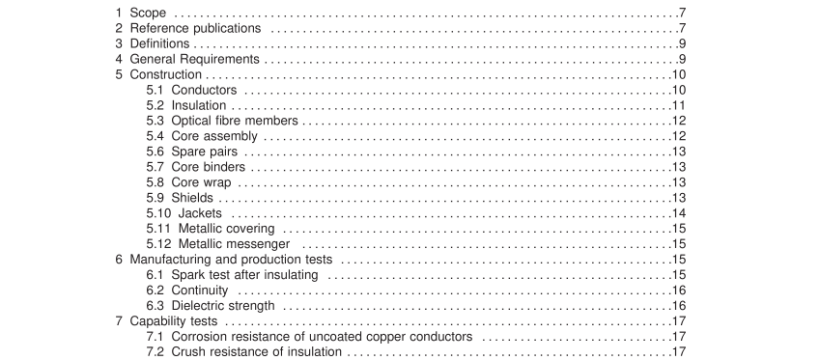UL 444-2008 pdf download.Communications Cables.
3 Definitions 3.1 The following definitions apply in this standard: 3.2 BONDED METAL SHIELD – A covering over the cable core assembly consisting of a metal tape whose outer surface is adhesively bound to a polymeric jacket over it. 3.3 CAPABILITY TEST – A test that is conducted periodically on a cable component, or on a completed cable, intended to be proof of adequate construction and processing, and that is repeated for verification. 3.4 COAXIAL CABLE – A cable having one or more coaxial members, each consisting of a conductor centered inside one or more outer conductors consisting of metal tubes or shields, separated from the central conductor by a dielectric material. 3.5 COVERING – A jacket, sheath, or armour. 3.6 CROSS-CONNECT WIRE (CABLE) – A single- or multiple-conductor construction consisting of insulated conductors without an overall jacket. 3.7 DIELECTRIC – An insulating (nonconducting) medium. 3.8 EQUIVALENT GAUGE – A round conductor AWG number used to designate a flat conductor that has a cross-sectional area equal to that of the round conductor. 3.9 GROUND PLANE – A partially encompassing shield provided to reduce stray electrical fields. 3.1 0 INTEGRAL COVERING – A single extruded layer that serves as both insulation and jacket. 3.1 1 JACKET – A continuous nonmetallic outer covering. 3.1 2 MANUFACTURING AND PRODUCTION TEST – A test performed on a length of wire before further processing and/or on a completed cable before shipment.
5 Construction 5.1 Conductors 5.1 .1 The conductors shall be solid or stranded, annealed, bare or metal-coated copper. The centre conductor of coaxial cables is also permitted to be a smooth or corrugated copper tube. The centre conductor of CMP, CMR, CMG, CM, CMH and CMX coaxial cables made of copper-clad steel shall have 21 percent or higher conductivity in accordance with ASTM Standard B 869. 5.1 .1 revised April 30, 201 5 5.1 .2 The centre conductor of CMP, CMR, CMG, CM and CMX coaxial cables made of copper-clad aluminum shall be in accordance with ASTM B 566. 5.1 .3 If the insulation adjacent to the copper conductor is of a material that corrodes unprotected copper in the test described in Clause 7.1 , the conductor shall be covered with a coating of tin complying with ASTM Standard B 33, of lead or lead-alloy complying with ASTM Standard B 1 89, of nickel complying with ASTM Standard B 355, of silver complying with ASTM Standard B 298, or of another metal or alloy. Evaluation of the effectiveness of these coatings shall be required. Metal-coating a conductor on which the coating is not required for corrosion protection shall be permitted. When this is done, the 1 00 per cent coverage requirement of the relevant ASTM Standard shall be waived. The maximum temperature rating of cables relative to the diameter and coating of solid copper conductors or copper conductor strands or the thickness and coating of tubular copper conductors shall not be higher than those shown in Table 1 . 5.1 .3 revised April 30, 201 5 5.1 .4 For stranded conductors, the length of lay of the strands shall not exceed 20 times the calculated diameter over the assembled conductor for 1 9 – 6 AWG conductor, or 30 times for 30 – 20 AWG conductor. The direction of lay of the strands may be right- or left-hand. 5.1 .5 The conductors shall be continuous when tested in accordance with Clause 6.2.
5.2 Insulation 5.2.1 Each conductor shall be insulated with one or more continuous layers of solid and/or expanded material. The insulation shall be uniform and shall not have any defects (bubbles, open spots, rips, tears, cuts, or foreign material) that are visible without magnification to normal or corrected-to-normal vision . The average thickness of the insulation and the minimum thickness at any point of the insulation are not specified. The average thickness of insulation used, including the average thickness of the tube portion of an air-gap coaxial member, shall be determined by means of an optical device. The method for measuring the thickness of insulation and for rounding off the results shall be as described in Clause 7.1 5. 5.2.2 The insulation in an air-gap coaxial member shall consist of a solid or foam tube over a solid or foam spacer. 5.2.3 Each conductor, including the centre conductor for a coaxial member, shall meet the dc or ac spark test as described in Clause 6.1 after being insulated and before any subsequent operation. One hundred per cent of product shall be tested by the manufacturer at the factory. 5.2.4 The thickness of insulation at any point in a cable with a separable jacket (non-integral construction) shall be sufficient to meet the applicable manufacturing and production tests of Clause 6 and the capability tests of Clause 7. The thicknesses of the integral insulation (solid) and jacket in 2-, 3-, or 4-conductor flat, parallel cable shall be not less than as indicated in Table 6. 5.2.5 The insulated conductors shall be distinctly identified. 5.2.6 The insulated conductors shall be suitable for indoor use where normal conditions are such that cables may be subjected to maximum operating conditions from 60 – 250°C, inclusive. See Clause 7.3 for temperature rating requirements.UL 444-2008 pdf download.
UL 444-2008 pdf download
